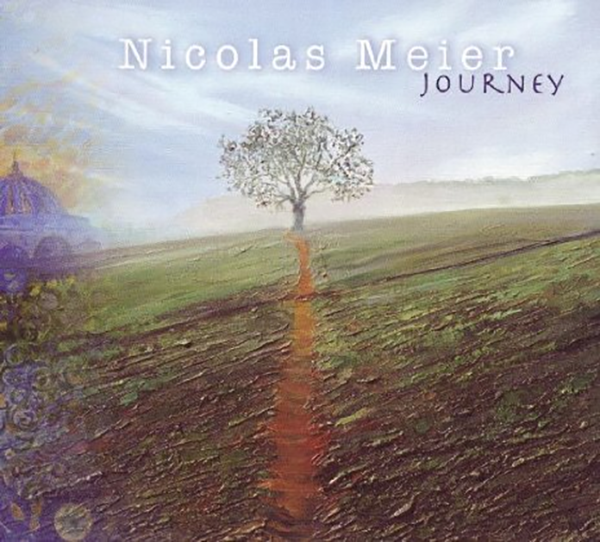
by Ian Mann
March 18, 2010
/ ALBUM
"Journey" sees Meier blending his various influences into a coherent and highly personalised whole that is also wholly satisfying to the listener
Swiss born but based in London guitarist Nicolas Meier is a versatile musician, as at home with heavy metal as he is with jazz. As a jazz musician one of Meier’s primary influences is the music of the Middle East, a love nurtured by his Turkish wife Songul and by his frequent collaborations with the extraordinary saxophonist/clarinettist Gilad Atzmon. He is also an admirer of fellow guitarist Pat Metheny’s style of fusion and in the past Meier’s music has sounded rather too much like that of his hero. The only other Meier album I’ve heard 2005’s “Orient” (reviewed elsewhere on this site) contained much fine music but there were times when Meier did come over as something of a Metheny clone.
“Journey” is a far more mature and personal piece of work. Meier has ditched the guitar synths and concentrates in the main on nylon strung guitar with the lute like glissentar and the baglama or saz adding an extra touch of eastern exotica to his work . Atzmon, heard here on clarinet plus alto and soprano saxophones remains from the “Orient” album as does the wonderful drummer Asaf Sirkis. The line up this time round is completed by the Uruguayan pianist Jose Reinoso and the electric bassist Patrick Bettison who also adds some fine harmonica playing to the session.
“Journey” is structured as an eight part suite bookended by the complementary pieces “Sunrise” and “Sunset”. The overt Methenyisms are gone but something of Pat’s influence remains in the structure of the tunes, all are highly melodic and exhibit a strong pictorial quality.
The melodies for the opening and closing pieces were originated by Songul (who also provides the album’s distinctive artwork) from traditional Turkish song forms and were expanded upon by Meier. “Sunrise” begins with the sound of Meier’s nylon strung guitar quickly joined by piano and then the rest of the band. Atzmon adds the distinctive sound of his clarinet but the most unusual element is Bettison’s harmonica which works superbly in this context. Metheny is perhaps an indirect influence here, he has deployed Toots Thielmans and Gregoire Maret to good effect in the past and Meier may have had this in mind.
After the delicately flowing melodies of “Sunrise” the suite abruptly segues into the effervescent “Journey” with Atzmon’s clarinet leading a merry dance punctuated by moments of lyricism from Meier and Reinoso.
The lengthy “Mountain Baba” sees Meier switching to steel strings as the piece unfolds in unhurried but quietly dramatic fashion. Sirkis’ subtly colourful percussion is a feature throughout and there are wonderful solos from Atzmon and Meier. Gilad’s clarinet broods and flutters before taking flight and Meier’s guitar follows a similar path, simmering rather than boiling. There is a strong cinematic quality to the piece and like everything else on the album it flows into the following piece “Silent Lands”. Atzmon is heard on saxophones here soloing on soprano above Bettison’s electric bass rumble, Sirkis’ crisp drumming and Reinoso’s piano colourations. Atzmon is a considerable presence throughout the album and his dazzling work here is something of a show stopper. Reinoso has to follow him and it has to be said that his tumbling, percussive solo is also highly impressive.
The breezy “Summit” initially maintains the energy levels and at twelve minutes plus is the lengthiest track on the record. The fleet fingered Meier takes the first solo shadowed by Bettison’s bass groove and Sirkis’ neatly energetic drumming. Following Meier’s frequently dazzling solo the band drop out leaving Atzmon on solo clarinet to conjure up images of the muezzin’s wail. There are vocals too, Atzmon I suspect, although no one is credited. He then switches to soprano for a stunning solo matched every step of the way by Sirkis’ explosive drumming. It’s the percussionist himself who next takes the spotlight hurling himself around his kit to the accompaniment of Reinoso’s piano chording.
After the blistering “Summit” “Promenade In the Lantern Garden” represents a total change of mood. Here Meier deploys the fretless eleven string glissentar with it’s low tone and deep, overtly oriental sound. The music Meier coaxes from the instrument is mysterious and vaguely unsettling. It’s offset by the beauty of Bettison’s harmonica solo, easily his most distinctive playing on the album.
“Marble Dance” allies eastern melodies to the martial drumming of Sirkis and as the piece gathers momentum there are fleeting solo statements from Meier, Reinoso and Atzmon, the leadership baton changing hands several times on this celebratory piece. The closing “Sunset” is a brief reprise of the opening melody played solo by Meier.
Conceived as a single entity “Journey” is an album to be listened to in it’s entirety. Like any journey there are plenty of twists and turns along the way and Meier and his group offer a wide range of moods, colours and textures many of them highly exotic to Western ears. The writing is imaginative and colourful and decidedly cinematic in it’s scope and the playing from an exceptionally talented band is magnificent throughout.
“Journey” sees Meier blending his various influences into a coherent and highly personalised whole that is also wholly satisfying to the listener. There are some great tunes here and this is an album that deserves to be heard by a wide audience.
blog comments powered by Disqus